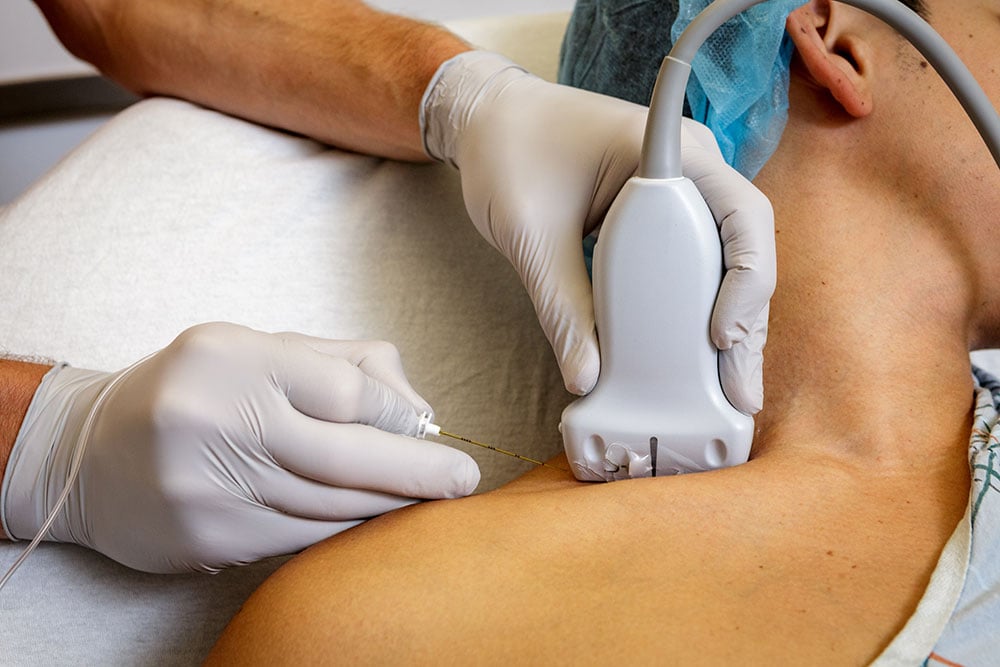Overview
Peripheral nerve stimulation or PNS is a rapidly growing effective treatment for nerve pain. PNS uses either a temporary or permanent implantable wire to stimulate nerves near the area of injury or pain. These wires use a small amount of electrical energy to block pain and provide relief. The benefit of this therapy is the precision and ability to focus on specific areas that otherwise could not be treated with previously available conventional measures. PNS does not eliminate the source of pain; it simply interferes with the signal to the brain. The goal for relief is a 50-100% reduction in pain. Your physician will discuss with you the temporary options vs permanent options. Both have been shown to provide long lasting relief.

What conditions are treated with peripheral nerve stimulation?
There are many neuropathic pain or nerve pain conditions treated with peripheral stimulation. This treatment is commonly used to treat the following conditions: mononeuropathy, pain after trauma, complex regional pain syndrome (CRPS), neuropathy, pain after total joint surgery, pelvic pain, chronic back pain, chronic shoulder pain, and post-stroke pain. Most patients with these conditions experience 50-100% relief.
How is the procedure performed?
Our team will help position you to make sure the procedure can be completed with the least amount of discomfort for you. The skin is cleansed with a sterilizing solution (chlorhexidine) and a sterile drape is placed. A local anesthetic medication typically (Lidocaine) is given to numb the skin. Next, fluoroscopy (x-ray) or ultrasound is used to find the target.
Once it is in the right place, the representative from the company will help program it to make sure it is in the best possible location for each patient. During the entire procedure you will be constantly monitored by our team. You will be given time after the procedure to make sure you feel good and are not having side-effects before leaving the clinic.
Does the procedure hurt?
The procedure is typically well tolerated. Mild to moderate soreness for a week after the procedure is normal.
How long does the procedure take?
The procedure typically takes about 1-2 hours to perform. Please plan on being at the clinic for about 3-4 hours to allow for pre and post-procedural safety protocols.
Can I have the injection if I have diabetes?
Yes. It is important to control your blood sugar before and after the procedure. Diabetic patients may experience a temporary increase in blood sugar which should be monitored closely for days following the procedure.
What are the risks and side effects?
Risks and side effects are minimal and serious complications are rare. We take every precaution to ensure safety. Potential risks may include but are not limited to: vasovagal response (passing out), new or increased pain, infection, bleeding, permanent skin changes, allergic or unexpected drug reaction with minor or major consequences, and unintended nerve injury.
Pre-Procedure Information
Please let us know if you have an active infection, are using antibiotics, or are using blood thinners.
Should I take my normal medications as scheduled?
Yes. Continue taking your prescribed medications prior to procedure.
What if I am on a blood thinner or Aspirin?
Anticoagulation is often stopped for a short period of time prior to injection. Please speak with your primary physician if you take blood thinners to make sure that you can safely stop taking these medications.
Do I need a driver?
Yes. For your safety we require a driver to ensure safe return home.
Can I eat the day of the procedure?
Do not eat any after midnight the night before the procedure. You must fast for at least 8 hours prior to the procedure.
Can I get sedation or anesthesia?
Depending on the location of the procedure anesthesia may be considered.
What if I am pregnant?
There are serious potential risks to an unborn fetus when exposed to imaging studies, including x-ray and fluoroscopy. If there is any chance you may be pregnant, please postpone this procedure until it can be confirmed that you are not pregnant as it is not safe to do during pregnancy.
What should I wear?
We recommend light loose-fitting clothes. We will ask you to change into a gown.
Post-Procedure Information
When can I drive after the procedure?
We recommend limiting driving until you feel minor pain and are not requiring any additional medication.
What can I do if I am sore or have pain after the procedure?
Ice packs can be applied to the area for 20 minutes per hour. Over the counter Tylenol and Motrin can be used to aid with any discomfort. Prescription pain medications are sometimes provided.
What are my restrictions after the procedure?
You will have minor limitations for 6 weeks for the permanent implant. We recommend limiting any bending, lifting, or twisting. We recommend not lifting anything greater than 5 LBS.
When can I shower?
This will be reviewed on the day of the procedure depending on location of pain. Most patients can return to showering within 3 days of less.
When do I come back for a follow-up visit?
We follow-up with all of our patients after their procedures. We typically see patients back every 4-6 weeks.
